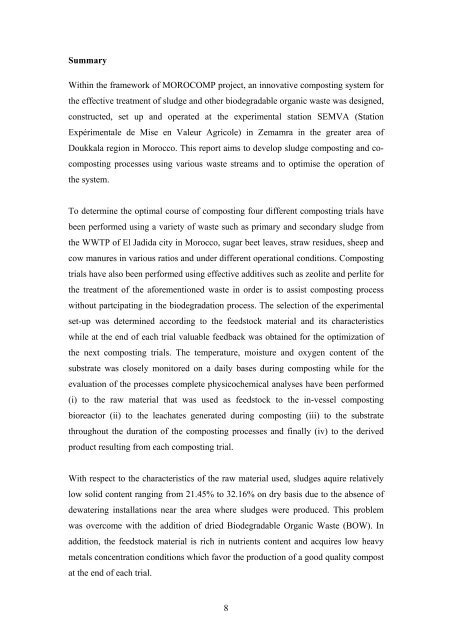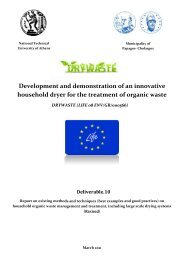MOROCOMP (LIFE TCY05/MA000141) - Unit of Environmental ...
MOROCOMP (LIFE TCY05/MA000141) - Unit of Environmental ...
MOROCOMP (LIFE TCY05/MA000141) - Unit of Environmental ...
Create successful ePaper yourself
Turn your PDF publications into a flip-book with our unique Google optimized e-Paper software.
Summary<br />
Within the framework <strong>of</strong> <strong>MOROCOMP</strong> project, an innovative composting system for<br />
the effective treatment <strong>of</strong> sludge and other biodegradable organic waste was designed,<br />
constructed, set up and operated at the experimental station SEMVA (Station<br />
Expérimentale de Mise en Valeur Agricole) in Zemamra in the greater area <strong>of</strong><br />
Doukkala region in Morocco. This report aims to develop sludge composting and cocomposting<br />
processes using various waste streams and to optimise the operation <strong>of</strong><br />
the system.<br />
To determine the optimal course <strong>of</strong> composting four different composting trials have<br />
been performed using a variety <strong>of</strong> waste such as primary and secondary sludge from<br />
the WWTP <strong>of</strong> El Jadida city in Morocco, sugar beet leaves, straw residues, sheep and<br />
cow manures in various ratios and under different operational conditions. Composting<br />
trials have also been performed using effective additives such as zeolite and perlite for<br />
the treatment <strong>of</strong> the aforementioned waste in order is to assist composting process<br />
without partcipating in the biodegradation process. The selection <strong>of</strong> the experimental<br />
set-up was determined according to the feedstock material and its characteristics<br />
while at the end <strong>of</strong> each trial valuable feedback was obtained for the optimization <strong>of</strong><br />
the next composting trials. The temperature, moisture and oxygen content <strong>of</strong> the<br />
substrate was closely monitored on a daily bases during composting while for the<br />
evaluation <strong>of</strong> the processes complete physicochemical analyses have been performed<br />
(i) to the raw material that was used as feedstock to the in-vessel composting<br />
bioreactor (ii) to the leachates generated during composting (iii) to the substrate<br />
throughout the duration <strong>of</strong> the composting processes and finally (iv) to the derived<br />
product resulting from each composting trial.<br />
With respect to the characteristics <strong>of</strong> the raw material used, sludges aquire relatively<br />
low solid content ranging from 21.45% to 32.16% on dry basis due to the absence <strong>of</strong><br />
dewatering installations near the area where sludges were produced. This problem<br />
was overcome with the addition <strong>of</strong> dried Biodegradable Organic Waste (BOW). In<br />
addition, the feedstock material is rich in nutrients content and acquires low heavy<br />
metals concentration conditions which favor the production <strong>of</strong> a good quality compost<br />
at the end <strong>of</strong> each trial.<br />
8










